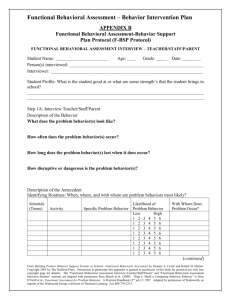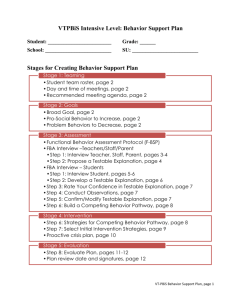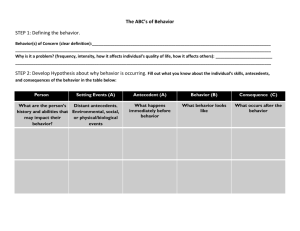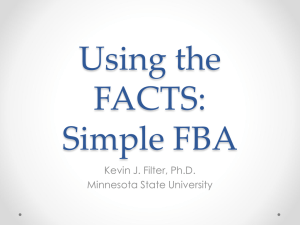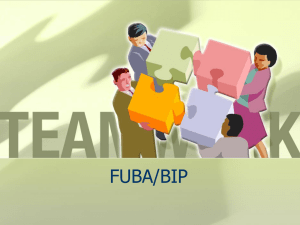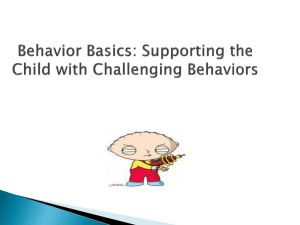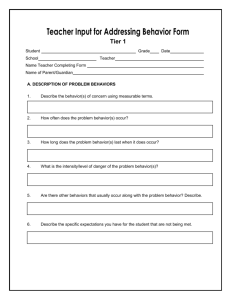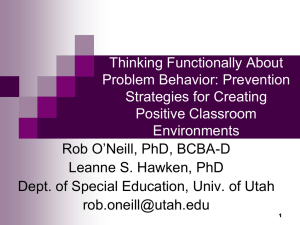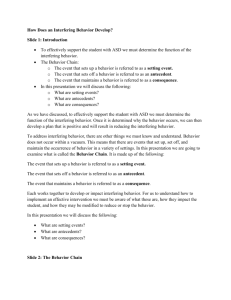Preliminary Functional Behavioral Assessment
advertisement
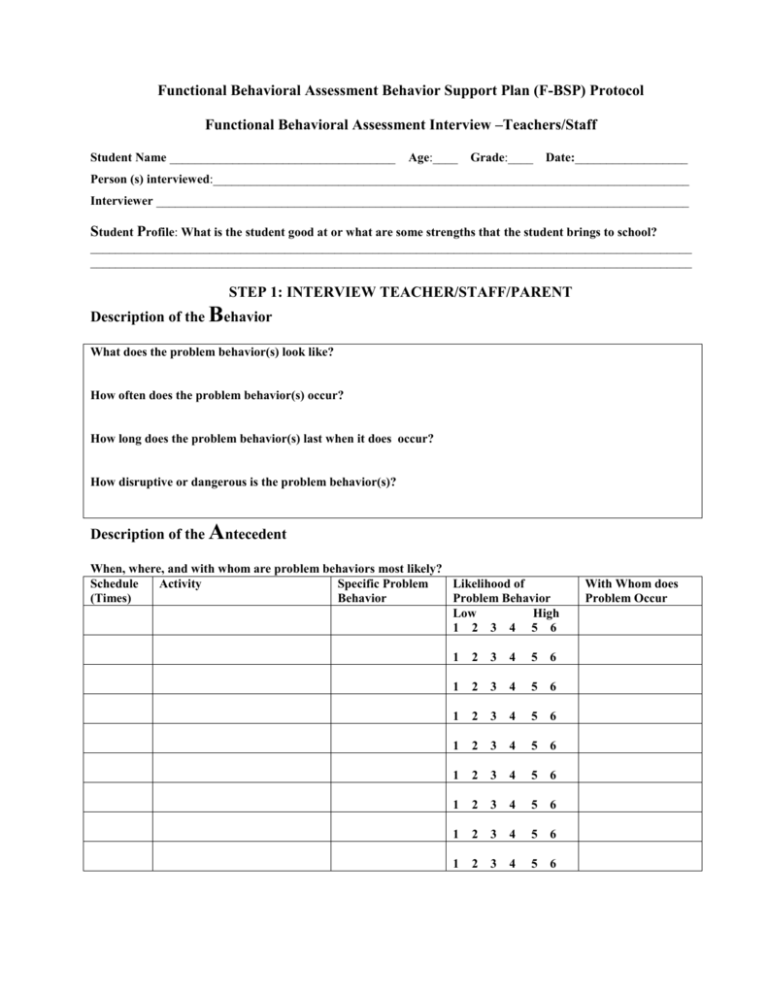
Functional Behavioral Assessment Behavior Support Plan (F-BSP) Protocol Functional Behavioral Assessment Interview –Teachers/Staff Student Name ____________________________________ Age:____ Grade:____ Date:__________________ Person (s) interviewed:____________________________________________________________________________ Interviewer _____________________________________________________________________________________ Student Profile: What is the student good at or what are some strengths that the student brings to school? ________________________________________________________________________________________________ ________________________________________________________________________________________________ STEP 1: INTERVIEW TEACHER/STAFF/PARENT Description of the Behavior What does the problem behavior(s) look like? How often does the problem behavior(s) occur? How long does the problem behavior(s) last when it does occur? How disruptive or dangerous is the problem behavior(s)? Description of the Antecedent When, where, and with whom are problem behaviors most likely? Schedule Activity Specific Problem Likelihood of (Times) Behavior Problem Behavior Low High 1 2 3 4 5 6 1 2 3 4 5 6 1 2 3 4 5 6 1 2 3 4 5 6 1 2 3 4 5 6 1 2 3 4 5 6 1 2 3 4 5 6 1 2 3 4 5 6 1 2 3 4 5 6 With Whom does Problem Occur Summarize Antecedent (and Setting Events) What situations seem to set off the problem behavior? (difficult tasks, transitions, structured activities, small group settings, teacher’s request, particular individuals, etc.) When is the problem behavior most likely to occur? (times of day and days of the week) When is the problem behavior least likely to occur? (times of day and days of the week) Setting Events: Are there specific conditions, events, or activities that make the problem behavior worse? (missed medication, history of academic failure, conflict at home, missed meals, lack of sleep, history or problems with peers, etc.) Description of the Consequence What usually happens after the behavior occurs? (what is the teacher’s reaction, how do other student’s react, is the student sent to the office, does the student get out of doing work, does the student get in a power struggle, etc.) - - - - - - End of Interview - - - - - STEP 2: PROPOSE A TESTABLE EXPLANATION Setting Event Antecedent Behavior Consequence 1. 2. Function of the Behavior For each ABC sequence listed above, why do you think the behavior is occurring? (to get teacher attention, to get peer attention, gets desired object/activity, escapes undesirable activity, escapes demand, escapes particular people, etc.) 1._____________________________________________________________________________________________ 2._____________________________________________________________________________________________ How confident are you that your testable explanation is accurate? Very sure So-so 6 5 4 Not at all 3 2 1 Functional Behavioral Assessment Interview – Students Student Name _____________________ Age:____ Grade:____ Date:_________________ Interviewer ______________________________________________________________________ Student Profile: What are things that you like to do, or do well, while at school? (E.g. activities, classes, helping others, etc.)______________________________________________________________________________________ ________________________________________________________________________________________________ STEP 1: INTERVIEW STUDENT Description of the Behavior What are some things you do that get you in trouble or that are a problem at school? (e.g. talking out, not getting work done, fighting, etc.) How often do you _______________ ? ( Insert the behavior listed by the student) How long does __________________ usually last each time it happens? How serious is _________________? (Do you or another student end up getting hurt? Are other students distracted?) Description of the Antecedent Where, when and with whom are problem behaviors most likely? Schedule Activity With Whom does (Times) Problem Occur Likelihood/Intensity of Problem Behavior Low High 1 2 3 4 5 6 1 2 3 4 5 6 1 2 3 4 5 6 1 2 3 4 5 6 1 2 3 4 5 6 1 2 3 4 5 6 1 2 3 4 5 6 1 2 3 4 5 6 1 2 3 4 5 6 1 2 3 4 5 6 Specific Problem Behavior Summarize Antecedent (and Setting Events) What kind of things make it more likely that you will have this problem? (difficult tasks, transitions, structured activities, small group settings, teacher’s request, particular individuals, etc.) When and where is the problem most likely to happen? (days of week, specific classes, hallways, bathrooms) When is the problem behavior least likely to occur? (days of week, specific classes, hallways, bathrooms) Setting Events: Is there anything that happens before or after school or in-between classes that make it more likely that you’ll have a problem? (missed medication, history of academic failure, conflict at home, missed meals, lack of sleep, history or problems with peers, etc.) Description of the Consequence What usually happens after the problem occurs? (what is the teacher’s reaction, how do other student’s react, is the student sent to the office, does the student get out of doing work, does the student get in a power struggle, etc.) - - - - - - End of Interview - - - - - STEP 2: DEVELOP A TESTABLE EXPLANATION Setting Event Antecedent Behavior Consequence 1. 2. 3. Function of the Behavior For each ABC sequence listed above, why do you think the behavior is occurring? (to get teacher attention, to get peer attention, gets desired object/activity, escapes undesirable activity, escapes demand, escapes particular people, etc.) 1._____________________________________________________________________________________________ 2._____________________________________________________________________________________________ 3._____________________________________________________________________________________________ STEP 3: RATE YOUR CONFIDENCE IN THE TESTABLE EXPLANATION If you completed both interviews, was there agreement on these parts? (Y/N) (a) Setting Events ___ (b) Antecedents ___ (c) Behaviors ___ (d) Consequences ___ (e) Function ___ How confident are you that your testable explanation is accurate? Very sure 6 So-so 5 4 3 Not at all 1 2 STEP 4: CONDUCT OBSERVATIONS (IF NECESSARY) If student has an identified disability and is at risk of suspension, expulsion, or change in placement you must conduct an observation of student If student does not meet above criteria, but confidence rating is 1, 2, 3, or 4 you should conduct observations to better understand when, where, and why the problem behavior is occurring. If student does not meet above criteria, and confidence rating is 5 or 6, you may go directly to Step 6 Summarize Observation Data Setting Event Antecedent Behavior Consequence 1. 2. 3. Function of the Behavior For each ABC sequence listed above, why do you think the behavior is occurring? (to get teacher attention, to get peer attention, gets desired object/activity, escapes undesirable activity, escapes demand, escapes particular people, etc.) 1._____________________________________________________________________________________________ 2._____________________________________________________________________________________________ 3._____________________________________________________________________________________________ STEP 5: CONFIRM/MODIFY TESTABLE EXPLANATION Was there agreement between the Teacher Interview and the Observation? Y/N a) Setting Events ___ (b) Antecedents ___ (c) Behaviors ___ (d) Consequences ___ (e) Function ___ Was there agreement between the Student Interview and the Observation? Y/N a) Setting Events ___ (b) Antecedents ___ (c) Behaviors ___ (d) Consequences ___ (e) Function ___ Based on the interviews and observations, what is your working testable explanation for why the problem behavior occurs? __________________________________________________________________________________________________ __________________________________________________________________________________________________ STEP 6: BUILD A COMPETING BEHAVIOR PATHWAY Setting Event Antecedent Desired Behavior Consequence Problem Behavior Consequence Function Alternative Behavior Setting Event Strategies Antecedent Strategies Behavior Teaching Strategies Consequence Strategies STEP 7: SELECT INITIAL INTERVENTION STRATEGIES Tasks Person Responsible By When Review Date Evaluation Decision Monitor Modify Discontinue *If emergency behavior management procedures are necessary, attach crisis plan as separate sheet. STEP 8: EVALUATE PLAN Behavioral Goal (Use specific, observable, measurable descriptions of goal) What is the short-term behavioral goal? _________ Expected date What is the long-term behavioral goal? _________ Expected date Evaluation Procedures Data to be Collected Procedures for Data Collection Person Responsible Timeline Plan review date:_________________ We agree to the conditions of this plan: _______________________________ Student (date) ______________________________ Parent or guardian (date) _______________________________ Teacher (date) ______________________________ Teacher (date) _______________________________ Action Team member (date) ______________________________ Action Team member (date)
